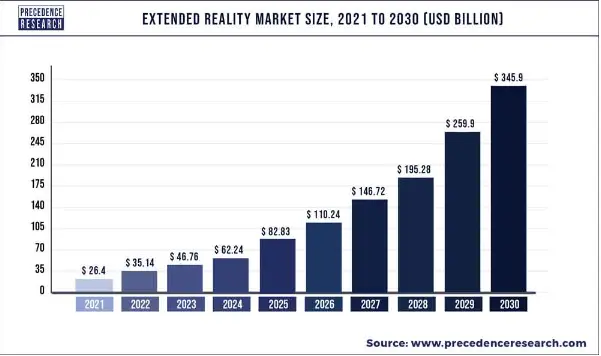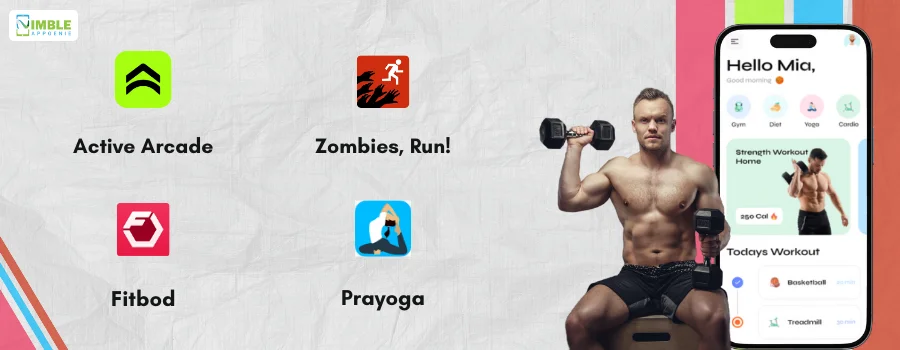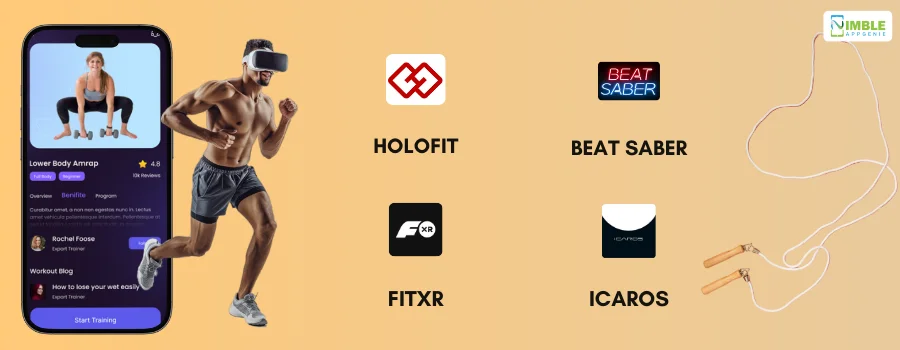From the phones to our TV, tech has often kept us glued to one place, but not anymore. The tides are turning! Augmented Reality and Virtual Reality apps are transforming the fitness industry, revolutionizing workouts from monotonous routines into immersive adventures.
With these technologies incorporated into your fitness apps, your sweaty workouts can become fun & engaging, making you come back for more.
This gives everyone hope for the bright future of the fitness industry, AR and VR are now poised to not only change the way we exercise but also make it accessible to a huge audience.
Let’s get to know about how AR and VR apps are gamifying the fitness industry.
What is AR and VR?
As we talk so highly of AR and VR trends, after all, they are creating immersive experiences that are completely challenging the way we interact with the world around us, including Fitness. But what exactly are VR and AR, how do they differ?
► Virtual Reality: Enhancing the Real World With Digital Overlays
VR is a technology that transports you entirely into a computer-generated environment.
By wearing a VR headset, you are shut off from the real world and surrounded by a fully immersive, 3D simulation. This simulation can be anything from a breathtaking mountain vista, to the inside of a human cell.
VR utilizes sophisticated technologies like motion tracking to create a sense of presence, allowing you to move around and interact with virtual objects as if they were real.
This level of immersion makes VR particularly well-suited for training simulations, education, and of course, the rapidly growing field of VR gaming.
And, Fitness, is among the five industries that are harnessing the power of VR to provide amazing experiences. Apps like FitXR are proof of that.
► Augmented Reality
AR, on the other hand, doesn’t completely replace your physical environment.
Instead, it overlays digital elements onto the real world you see through your smartphone camera or specialized AR headset. Think of it like placing a digital filter over your reality.
This filter can add information, characters, or even entire virtual objects that seamlessly blend with your surroundings.
For example, Fyter uses skeletal tracking technology to monitor your reps and form, and can even overlay AR obstacles to create a more engaging workout.
The Key Difference: Immersion Vs Enhancement
To clear your any type of confusion, the core difference between AR and VR lies in the level of immersion. VR completely immerses you in a simulated world, while AR enhances your existing reality with digital overlays.
Whereas VR requires specialized headsets to function, while AR can be accessed through smartphones or mobile.
Both AR and VR have the potential to revolutionize fitness experiences, but they offer different approaches. With the above context, we believe you have got an idea.
AR and VR Market Size
How are AR and VR shaping the market? Let’s get to know through these market stats:
 The extended reality (XR) market, which encompasses augmented reality (AR) and virtual reality (VR), is experiencing explosive growth. Here’s a breakdown of the key takeaways:
The extended reality (XR) market, which encompasses augmented reality (AR) and virtual reality (VR), is experiencing explosive growth. Here’s a breakdown of the key takeaways:
- Market Size Surge: In 2022, the XR market was valued at a cool $35.14 billion. By 2030, that number is expected to skyrocket to a staggering $345.9 billion, reflecting a compound annual growth rate (CAGR) of 33.09%.
- AR Reigns Supreme (For Now): As of now, AR holds the dominant position, capturing over 55% of the market share. However, VR is projected to experience significant growth in the coming years.
- Software Takes the Lead: The software segment within the XR market is predicted to be the main driver of growth from 2022 to 2030. This signifies the increasing importance of the programs and applications that power these immersive experiences.
- North America Leads the Pack: As per Fitness Stats, the North American region is currently the frontrunner in the global XR market, and this dominance is expected to continue through 2030. However, with the increasing interest in AR and VR worldwide, other regions are likely to catch up soon.
The market is seeing a sudden spike in AR and VR integration in various industries, and fitness is no exception. There are many breathwork apps, fitness apps, and yoga apps that are leveraging AR and VR to create more engaging and immersive workout experiences. And now we have AR and VR fitness apps painting a clear picture of the future is here.
Impact of AR and VR Apps on Fitness
Working through the same old workout routine? You don’t have to. As, AR & VR is making exercise fun, effective, and totally immersive!
Let’s dive into how AR and VR apps can supercharge your fitness journey.
![Impact_of_AR_and_VR_Apps_on_Fitness[1]](https://www.nimbleappgenie.com/blogs/wp-content/uploads/2024/07/Impact_of_AR_and_VR_Apps_on_Fitness1.webp)
1] Gamified Workouts for Enhanced Motivation
VR and AR fitness apps transform exercise into interactive games.
This gamification keeps users engaged, promotes healthy competition through new challenges, and doesn’t make exercise feel less like a bore.
It allows users to earn points for completing exercises; unlocking badges for achieving milestones and receiving virtual rewards for consistent effort. It surely acts as a powerful motivator.
Moreover, it opens exciting avenues for workout app development, allowing for innovative and immersive workout experiences.
2] Personalized Training
The fitness landscape is undergoing a dramatic shift with AR & VR apps.
These immersive tools are not just creating exciting workout experiences, but paving the way for a better era of personalized training.
This personalized feedback ensures you maximize results and avoid injury. VR puts you in a virtual gym with a holographic personal trainer, giving you a feel of a gym without even leaving the house.
Whereas AR overlays virtual makers on your body, providing real-time feedback on your posture and movement range, making sure you can tailor your workout as per your preference.
3] Data-Driven Workouts
VR and AR fitness apps can track real-time data like heart rate, calories burned, and movement range. And, with the growing number of health issues, this can be a boon for users.
In current times, people are looking for data-driven workouts, meaning they want exercise routines that are personalized and optimized based on their performance metrics.
This also shows that people are shifting quickly from generic workouts to personalized workouts for better results, causing an increase in demand for such apps.
4] Increased Accessibility
Fitness doesn’t require expensive gym memberships or specialized equipment. With just your fitness app, you can access a wide range of AR workouts, whereas VR erases the line between the digital and real world making fitness more convenient.
It transforms your surroundings into an interactive workout studio. And, without any doubt, this accessibility is revolutionary. No matter your location or budget, workouts can be done from anywhere and anytime.
As a result, the best fitness apps are embracing convenient and personalized fitness journeys right from your pocket.
5] Real-Time Feedback and Monitoring
AR and VR fitness apps provide real-time feedback about body posture, techniques, and performance during workouts.
This immediate feedback helps users to take steps in the right direction such as improving postures, optimizing their workouts, and saving themselves from any injury.
Besides that, it enhances accountability and motivation by providing transparent progress tracking & tailored guidance, making fitness goals more rewarding.
6] Enhanced Immersive Experience
When it comes to AR and VR in fitness, they are constantly elevating user engagement by creating immersive environments where users can delve completely into their workouts.
Since businesses have understood that it is not only about fancy visuals, they are more about engaging experience, ultimately helping users to reach goals, they are leveling up with these apps.
7] Promote Community and Social Interactions
You can foster community and social interactions, as it is one of the booming impacts of leveraging AR and VR apps in the fitness industry. These technologies allow fitness apps to create such an environment where users can take classes together or do challenges together, regardless of their physical location.
Although there are several development challenges in it, if done right, it can help users interact with each other through avatars, chat functionalities, and foster a sense of companionship and support.
What AR/VR Trends Are Elevating Workout Experiences?
As we talk so highly of AR and VR’s impact on workouts, it’s time to talk about how AR/VR trends are shaping the fitness app experience.
As the fitness landscape is changing rapidly, here are 7 key trends to watch:
![What_AR_VR_Trends_Are_Elevating_Workout_Experiences[1]](https://www.nimbleappgenie.com/blogs/wp-content/uploads/2024/07/What_AR_VR_Trends_Are_Elevating_Workout_Experiences1.webp)
-
Tailored Workout
Gone are the days of generic routines. With so much development in the fitness industry, emerging technologies i.e. AR/VR fitness apps with the power of AI can help to create personalized training programs based on fitness level.
Besides that, AR/VR apps can provide you with a virtual outlook of how your workout or a particular exercise should look. It’s fun and you get a companion for yourself.
-
Mind-Body Wellness Integration
AR/VR ensures to move beyond just physical fitness. Similar to mental health apps, this approach sees an interconnection between mind and body.
This is why they integrate mindfulness practices like meditation videos and create well-rounded programs that nourish your whole being.
-
Immersive Environment
AR/VR apps incorporate immersive environments and take out the boredom by transporting users to a totally different location.
Many workout streaming apps like Peloton are used for cycling or for running. But imagine taking this further, your running app is placing you on a virtual trail through a rainforest. Wouldn’t that be amazing?
It will definitely make a user’s workout more engaging. It will also help them to escape from the monotony of traditional gym settings and find inspiration in these virtual worlds.
-
Biometric Tracking
Moving beyond biometric authentication, we’re seeing a rise and a shift to biometric tracking, and for that, AR/VR fitness apps are leading the way.
Well, users can monitor their heart rate, calories burned, and other fitness metrics in real time, allowing them to take a sneak peek at their health.
This way, they can adjust their workouts, set new goals, and moreover track progress over time, enjoying valuable insights into the user’s fitness journey.
-
Gamification of Fitness Challenges
AR/VR fitness apps emphasize gamification elements that allow users to stay active.
These apps offer different challenges, quests, or achievements, providing users with rewards that push them further. Different meal planning apps like MyFitnessPal use gamification to let the user achieve their goal quickly and competently.
By turning fitness into a game, one can make boring exercises fun and keep their user engaged. Investors who are prepping for AR/VR apps know that it might affect their development cost, but will be worth it for a long time.
-
Diversity in Fitness
Fitness is no longer a one-trick thing. It’s rapidly expanding into a full-fledged fitness galaxy, offering a huge universe of workouts.
From a small breathing exercise to high-intensity workouts, there is a growing library to find the perfect workout as per your mood, goal, and preferences.
If one can overcome development challenges, then developing an AR/VR app can prove to be a game-changer in the fitness industry.
Examples of AR/VR Apps Improving Workout Experience
With that, let’s check out some AR/VR fitness apps that are ruling the world of fitness and motivating others to create a fitness app. Without any further ado, let’s get to know about them.
♦ AR Fitness Apps
First, let’s get to know about AR Fitness Apps.

1. Active Arcade
Well, Active Arcade is a famous fitness app that harnesses the power of AR; the game offers various interactive elements that make your fitness journey easy.
It’s a perfect app for those who want a fun and accessible way to get out of the fitness boredom.
2. Zombies, Run!
Zombies, Run! The name itself is so unique.
This exceptional app transforms running into a mission by placing a zombie apocalypse. You can collect different supplies, complete your quests, and stay motivated by the immersive story.
So, if you want a fun AR fitness app, we recommend Zombies, Run!
3. Fitbod
Another app that’s offering AR fitness is Fitbod. The app leverages AR to guide you through a proper form for weightlifting exercises.
It simply offers instructions and highlights key muscle groups you’re targeting for a safer and more effective workout experience.
4. Prayoga
Prayoga is a perfect example of yoga app development combined with AR. It’s an iOS-exclusive app that provides real-time feedback on your yoga poses.
The app offers various guided courses designed by yoga experts, targeting different experience levels. These courses can help to improve strength, balance & mindfulness.
♦ VR Fitness Apps
Now, let’s take a look at some famous VR Fitness Apps.

1. HOLOFIT
HOLOFIT is a famous VR fitness app that uses virtual reality to gamify your workout routine. Besides that, it also allows you to run, ski, or cycle in stunning virtual worlds, while getting a great workout.
Overall, HOLOFIT is a great option for people who want to have an amazing workout session with new experiments daily.
2. Beat Saber
Beat Saber is a popular VR rhythm game that combines music and exercise. One can slash colored blocks to the beat of music, doing an energetic workout.
You will not even know when you completed an hour of your exercise. So, you should definitely give this app a try.
3. FitXR
FitXR is a VR app that offers a variety of fitness classes, from dancing to HIIT training.
So, you can sweat it out in different virtual environments, keeping your workout fresh and engaging. It’s a VR playground that blends boxing, dance, and HIIT into one immersive experience.
If you are looking for a personal trainer app, such apps can be a great companion, what’s say?
With new classes daily and the option to sweat it out with friends, users will be having so much fun without even realizing it.
4. Icaros
Icaros is a VR fitness system that uses a special suit to track movements and immerse you in virtual flight experiences. You can soar through the skies or explore a new planet while staying fit.
Isn’t that a creative way to workout and complete your fitness journey?
So, these are some of the examples of top AR/VR apps transforming the fitness industry, now if you want to be a part of it, then you should take the service of an experienced company, our next section is just about that.
How Nimble AppGenie Can Help You To Develop an AR/VR Fitness App?
Seeing such amazing apps and the market growth, who wouldn’t like to be part of such an amazing trend?
In this dynamic landscape to beat the competition, you should take the help of a market-leading fitness app development company, that’s none other than Nimble AppGenie.
To avoid any development mistakes and focus on creating a highly personalized and engaging user experience, we are of help. Our professionals and experts have ample years of experience to ensure that your app doesn’t only exceed expectations but also helps to establish you in the market.
So contact us today to be on the winning side.
Conclusion
The tides are turning in the fitness industry. AR and VR technologies are no longer a futuristic fantasy; they’re revolutionizing workouts, transforming them from monotonous routines into immersive adventures.
This is just the beginning. As AR and VR continue to evolve, so too will the possibilities for fitness experiences. So, lace up your virtual shoes, grab your VR headset, and get ready to embark on a whole new world of fitness!
Ready to join the movement? Partner with Nimble AppGenie to develop a cutting-edge AR/VR fitness app that will change the game. Let’s shape the future of fitness together!
FAQs
- Increased Engagement: Gamification elements and interactive experiences make exercise more fun and keep you motivated.
- Personalized Training: AR/VR apps can tailor workouts to your fitness level and goals.
- Real-time Feedback: Get immediate feedback on your form and technique to avoid injury and maximize results.
- Data-driven Workouts: Track your progress with metrics like heart rate, calories burned, and movement range.
- Accessibility: No gym membership or fancy equipment is needed. Work out anytime, anywhere.
- Immersive Experience: Escape the monotony of traditional workouts and explore virtual worlds.
- AR Apps: Active Arcade (interactive games), Zombies, Run! (story-driven running), Fitbod (form coaching for weightlifting)
- VR Apps: HOLOFIT (VR gamified workouts), Beat Saber (VR rhythm game), FitXR (VR fitness classes), Icaros (VR flight simulations)
- Choose your platform: Do you have a smartphone or VR headset?
- Explore different apps: Find one that suits your interests and fitness goals.
- Start with a free trial: Many apps offer free trials to test them out.
- Clear a space: Make sure you have enough room to move around safely.
- Have fun! AR/VR fitness should be enjoyable and motivating.
AR/VR fitness is a great option for people who:
- Find traditional workouts boring
- Want to try something new and exciting
- Need help to stay motivated
- Enjoy technology and gamification
- Cost: Some VR headsets and apps require a subscription.
- Accessibility: Not everyone has access to VR technology.
- Space Requirements: VR workouts often require a clear space for movement.
- Technical Challenges: AR/VR technology is still evolving.

Niketan Sharma is the CTO of Nimble AppGenie, a prominent website and mobile app development company in the USA that is delivering excellence with a commitment to boosting business growth & maximizing customer satisfaction. He is a highly motivated individual who helps SMEs and startups grow in this dynamic market with the latest technology and innovation.
Table of Contents




![CTA-1_--Be_A_Game-Changer![1]](https://www.nimbleappgenie.com/blogs/wp-content/uploads/2024/07/CTA-2_-Be_A_Game-Changer1.webp)
![CTA-2_--Shape_the_future_with_AR_VR_app[1]](https://www.nimbleappgenie.com/blogs/wp-content/uploads/2024/07/CTA-1_-Shape_the_future_with_AR_VR_app1.webp)
No Comments
Comments are closed.